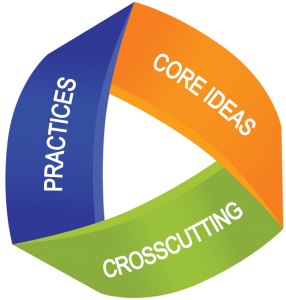Toolkit
The transition from a one dimensional teacher, defined as a teacher who focuses on a single dimension such as content standards, to a 3-Dimensional teacher, one who weaves all three dimensions into lessons as appropriate, is a complex cognitive, pedagogical and paradigm challenge. Simply stated, this is not a quick, painless process. The transition to a 3-Dimensional teacher should be viewed as a life-long journey over a continuum of change. For this reason, MPRES recommends that teachers interested in the Toolkit take advantage of one of the MPRES professional development options.
NGSS Background: What is 3D Teaching?
The Next Generation Science Standards were developed so that students could learn science in the way that scientists do science. In this framework, there were three dimensions developed that have equal importance. The Disciplinary Core Ideas for each grade band were revised, which were formerly referred to as the standards. In addition, the Scientific & Engineering Practices were added, which include the skills and methods that scientists have and use, and that students should also master. The practices are the methods, or the “how,” the content is explored. Finally, the dimension of Crosscutting Concepts was included, which is a knowledge base that adheres all of the fields of science, along with other unifying fields such as mathematics, social sciences and language arts. Crosscutting Concepts provide the lens, or focus, for the practice and content.
For more on what the conceptual change process and 3D teaching mean for teachers, take a look at From 1D to 3D.
If students are to learn these three dimensions, then all three must be explicitly taught. Each lesson and unit should be designed to incorporate all three dimensions, thus being 3-Dimensional. Additionally, every lesson should be assessed for how effective each dimension was taught and learned, and students should also be assessed in these dimensions objectively and effectively. Effective assessments reflect all three dimensions and do not separate them.
In order to implement these new standards, science must be perceived and taught differently. The focus should be on students grasping these skills, concepts and content, and students must be able to design their own investigations to answer their own questions. Emphasis should also be on student sense-making, discourse, and higher-level thinking. NGSS Content is more narrow and provides for deeper exploration of phenomena. Crosscutting Concepts and Practices are viewed as long-term learning goals throughout the entire school experience and, ultimately, life-long learning tools to aid in sifting through information and experiences.
Conceptual Change and the Toolkit
This change in teaching science requires a conceptual change for both the teacher’s pedagogy and the students’ skillset or mindset. This is a process, and the Toolkit is designed to provide tools for this change. This toolkit was developed as a professional development resource to train teachers in the concepts of the Framework for K-12 Science Education and the Next Generation Science Standards. It is the product of the STEM Framework Course component of the MPRES Grant. The purpose of the MPRES Toolkit is to assist teachers of science in the conceptual development and acquisition of the 3-Dimensions of the K-12 Science Framework (Scientific & Engineering Practices, Crosscutting Concepts, and Disciplinary Core Ideas).
 The Toolkit is not intended to be used as curriculum for classroom instruction, and it will not work as a recipe box that can be transfixed to specific classrooms. The tools provided here, along with a professional development trainer’s expertise, will help you bend and shape your classroom pedagogy into a 3-Dimensional form that is successful for your grade level, content, and style.
The Toolkit is not intended to be used as curriculum for classroom instruction, and it will not work as a recipe box that can be transfixed to specific classrooms. The tools provided here, along with a professional development trainer’s expertise, will help you bend and shape your classroom pedagogy into a 3-Dimensional form that is successful for your grade level, content, and style.
Examples of 1D, 2D and 3D lessons are provided, as well as testimonies from MPRES teachers on the changes they made and how they intentionally designed lessons to train students in all three dimensions and subsequently assess student mastery. Artifacts and examples of student work are also provided. Finally, rubrics and lesson templates are available for teachers to map their own conceptual change while implementing the NGSS.
The goal is that teachers of science fully implement Science & Engineering Practices in coordination with Crosscutting Concepts and Disciplinary Core Ideas in all their teaching, and that Practices and Crosscutting Concepts will become a natural component of their teaching repertoire.
A 3-Dimensional Teacher is one who integrates the 3-Dimensions of the K-12 Science Framework in all science instruction. View one teacher’s explanation of her beginning journey from a one dimensional to a three dimensional teacher:
Based on the work of Llewellyn (2013), becoming a 3-Dimensional Teacher involves five essential stages (p. 60):
- Building an understanding of the three dimensions
- Developing an understanding of the change process
- Constructing a mind-set for the emerging pedagogy
- Translating new knowledge into action
- Creating a culture of three dimensional practice
“In the final analysis, it’s important to realize how your goals and beliefs foster the legacy you create as a teacher.” (Llewellyn, 2013, p. 62)
This toolkit provides a starting point to engage in the steps listed above.
Start by reviewing A Framework for K-12 Science Education: Practices, Crosscutting Concepts and Core Ideas (2012) pages 1-40.
For more on the NGSS and the 3-Dimensions, take a look at the following videos from Brett Molding and Teaching Channel (videos require Adobe Flash Player):